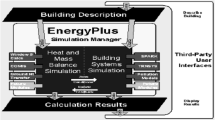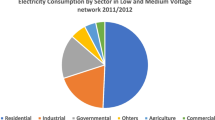Abstract
Natural ventilation or self-ventilation is an economical way to improve indoor air quality. Climate factors such as temperature, received radiation, humidity, and wind flow can significantly affect natural ventilation of the buildings. This study aimed to investigate the performance of some commonly known strategies such as building orientation, aperture area, and coating color to promote natural ventilation on the hot and humid climate of southern Caspian Sea, north of Iran. These techniques are traditionally used without any specific knowledge on their individual importance and mutual effects. As an advanced modeling tool for energy assessment, Design-Builder was used along with computational fluid dynamics tab to numerically evaluate the results of each change. Among the many possible cases, seven scenarios were investigated by developing a comprehensive computer simulation model. The results show that thermal comfort can be increased up to 30% and suitable airflow can be achieved by increasing the space on the windward side, roof window on the leeward side, and employing light-colored coating for the rooftop. Applying these factors decreased the apparent temperature up to 10 °C in the summer design week.










Similar content being viewed by others
Notes
Occupancy Kingston Benchmark.
References
Adamu ZA, Price ADF, Cook MJ (2012) Performance evaluation of natural ventilation strategies for hospital wards-A case study of Great Ormond Street Hospital. Build Environ 56:211–222
Aflaki A, Hirbodi K, Mahyuddin N, Yaghoubi M, Esfandiari M (2019) Improving the air change rate in high rise buildings through a transom ventilation panel: a case study. Build Environ 147:35–49
Baghaei DA, Khalatbari Limaki A, Safari H (2016) Opening performance simulation in natural ventilation using design-builder (case study: a residential home in Rasht). Energy Proc 100:412–422
Candido C, deDear R, Lamberts R, Bittencourt L (2010) Air movement acceptability limits and thermal comfort in Brazil’s hot humid climate zone. Build Environ 45:222–229
Chen Q (2004) Using computational tools to factor wind into architectural environment design. Energy Build 36:1197–1209
Elshafei G, Negam A, Bady M, Suzuki M, Ibrahim M (2017) Numerical and experimental of the impacts of window parameters on indoor natural ventilation in a residential building. Energy Build 141:321–332
Gao CF, Lee WL (2011) Evaluating the influence of openings configuration on natural ventilation performance of residential units in Hong Kong. Build Environ 46:961–969
Gratia E, Herde A (2004) Natural cooling strategies efficiency in an office building with a double-skin façade. Energy Build 36:1139–1152
Guo W, Liu X, Yuan X (2015) A case study on optimization of building design based on CFD simulation technology of wind environment. Procedia Eng 121:225–231
Hanan MT (2015) Natural ventilation as energy efficient solution for achieving low energy houses in Dubai. Energy Build 99:284–291
Hatamipour MS, Abedi A (2008) Passive cooling systems in buildings: some useful experiences from ancient architecture for natural cooling in a hot and humid region. Energy Convers Manag 49:2317–2323
Hu K, Chen Q (2015) Ventilation optimization for reduction of indoor semi-volatile organic compound concentration based on the variational principle. Build Environ 94:676–682
Hu C, Ohba M, Yoshie R (2008) CFD modelling of unsteady cross ventilation flows using LES. J Wind Eng Ind Aerod 96:1692–1706
Iranian national building code (2013) Iranian code of practice for seismic resistant design of buildings (standard no 2800)/permanent committee for revising the Iranian code of practice for seismic, Ministry of Road and Urban Development. Building & Housing Research center BHRC Publication No. S – 465. ISBN: 978-964-9903-41-5
Jamaludin AA, Hussein H, Ariffin A, Keumala N (2014) A study on different natural ventilation approaches at a residential college building with the internal courtyard arrangement. Energy Build 72:340–352
Kobayashi N, Chen Q (2003) Floor-supply displacement ventilation in a small office. Indoor Built Environ 12:281–291
Li H, Wang S, Cheung H (2018) Sensitivity analysis of design parameters and optimal design for zero/low energy buildings in subtropical regions. Appl Energy 228:1280–1291
Liu L, Wang L, Zhang Y, Dong B, Song B (2015) Study on ventilation rates at university dormitories in winter. Procedia Eng 121:743–748
Nejat P, Jomehzadeh F, Taheri MM, Gohari M, Majid MZA (2015) A global review of energy consumption, CO2 emissions and policy in the residential sector (with an overview of the top ten CO2 emitting countries). Renew Sustain Energy Rev 43:843–862
Orme M (2001) Estimates of the energy impact of ventilation and associated financial expenditures. Energy Build 33:199–205
Oropeza-Perez I (2015) Assessment of natural ventilation within buildings located on hot-temperate and mild-temperate regions. Energy Proced 78:1513–1518
Prajongsan P, Sharples S (2012) Enhancing natural ventilation, thermal comfort and energy savings in high-rise residential buildings in Bangkok through the use of ventilation shafts. Build Environ 50:104–113
Roetzel A, Tsangrassoulis A, Dietrich U, Busching S (2010) A review of occupant control on natural ventilation. Renew Sustain Energy Rev 14:1001–1013
Schulze T, Eicker U (2013) Controlled natural ventilation for energy efficient buildings. Energy Build 56:221–232
Seifert J, Li Y, Axley J, Rosler M (2006) Calculation of wind-driven cross ventilation in buildings with large openings. J Wind Eng Ind Aerodyn 94:925–947
Steadman RG (1994) Norm of apparent temperature in Australia. Aust Meteorol Mag 43:1–16
Tantasavasdi Ch, Srebric J, Chen Q (2001) Natural ventilation design for houses in Thailand. Energy Build 33:815–824
Yıldız Y, Durmus Z (2011) Identification of the building parameters that influence heating and cooling energy loads for apartment buildings in hot-humid climates. Energy 36:4287–4296
Yu CKH, Li M, Chan V, Lai ACK (2014) Influence of mechanical ventilation system on indoor carbon dioxide and particulate matter concentration. Build Environ 76:73–80
Zhang W, Wang L, Ji Z, Ma L, Hui Y (2015) Test on ventilation rates of dormitories and offices in University by the CO2 tracer gas method. Procedia Eng 121:662–666
Zhou C, Wang Z, Chen Q, Jiang Y, Pei J (2014) Design optimization and field demonstration of natural ventilation for high-rise residential buildings. Energy Build 82:457–465
Acknowledgements
The authors acknowledge the funding support of the Babol Noshirvani University of Technology through grant program No. BNUT/390035/97.
Author information
Authors and Affiliations
Corresponding author
Additional information
Editorial responsibility: Parveen Fatemeh Rupani.
Rights and permissions
About this article
Cite this article
Aram, M., Abessi, O. Optimal design of green buildings using computational fluid dynamics and climate simulation tools. Int. J. Environ. Sci. Technol. 17, 917–932 (2020). https://doi.org/10.1007/s13762-019-02403-6
Received:
Revised:
Accepted:
Published:
Issue Date:
DOI: https://doi.org/10.1007/s13762-019-02403-6




